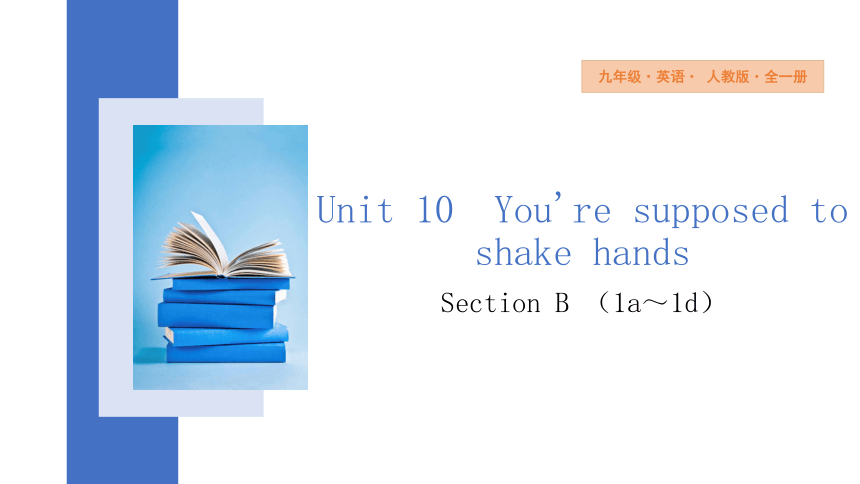Unit 10 You're supposed to shake hands. Section B (1a~1d)导学课件 (共18张PPT)
文档属性
| 名称 | Unit 10 You're supposed to shake hands. Section B (1a~1d)导学课件 (共18张PPT) |  | |
| 格式 | pptx | ||
| 文件大小 | 803.3KB | ||
| 资源类型 | 教案 | ||
| 版本资源 | 人教新目标(Go for it)版 | ||
| 科目 | 英语 | ||
| 更新时间 | 2023-12-18 15:25:07 | ||
图片预览







文档简介
(共18张PPT)
九年级·英语· 人教版·全一册
Unit 10 You're supposed to shake hands
Section B (1a~1d)
1.记住并能正确运用本课时的重点单词、短语和句型。
2.能听懂关于谈论不同国家餐桌礼仪的对话,知道不同国家的餐桌礼仪。
3.尊重不同国家的文化差异,养成良好的礼仪风范。
1.完成预习导学和任务驱动一,达成学习目标1。
2.完成任务驱动二,达成学习目标1、2。
3.完成任务驱动三,达成学习目标3。
教师可以向学生展示不同国家餐桌礼仪的图片来激发学生兴趣,同时,也能够帮助学生完成1a的判断。
一、生词速查
1. quiz n.小测验
2. impolite adj.不礼貌的→反义词, polite ,意为 有礼貌的
3. empty adj.空的;空洞的→反义词, full ,意为 满的
◎学法指导:注意记忆单词的词性和相关单词的拓展有助于提高词汇储备。
quiz
impolite
polite
有
礼貌的
empty
full
满的
二、短语速记(写出下列短语的英文)
1.插入 stick...into
2.餐桌礼仪 table manners
3.对准;指向 point at
4.开始做某事 start doing sth.
stick...into
table manners
point at
start doing sth.
三、句子速译(把下列句子翻译成中文)
1.In China,it’s impolite to use your chopsticks to hit an empty bowl.
在中国,用筷子敲击空碗是不礼貌的。
2.In India,you are supposed to eat with your hands.
在印度,你应该用手拿东西吃。
在中国,用筷子敲击空碗是不礼貌的。
在印度,你应该用手拿东西吃。
3.In Korea,the youngest person isn’t expected to start eating first.
在韩国,年龄最小的人不应该先吃饭。
在韩国,年龄最小的人不应该先吃饭。
4.It’s impolite to point at anyone with your chopsticks.
用你的筷子指着别人是不礼貌的。
用你的筷子指着别人是不礼貌的。
四、想一想
1.各国的餐桌礼仪相同吗?
略。
2.你觉得哪个国家的餐桌礼仪最有趣?
略。
略。
略。
听前热身
1.教师向学生展示各国餐桌礼仪的图片,并让学生就图片内容进行讨论。
How much do you know about table manners around the world?
In China,we shouldn’t use chopsticks to hit the bowl./...
2.完成课本1a。
In China,we shouldn’t use chopsticks to hit the bowl./...
听力训练
1.听第一遍录音,完成课本1b。
2.听第二遍录音,完成课本1c。
3.听第三遍录音,完成下面表格。
In China In America
You aren’t supposed to start eating first if there are older people at the table. It doesn’t matter.
It’s impolite to stick your chopsticks into your food. People use forks and knives to eat.
You shouldn’t point at anyone with your chopsticks.
start eating
first
stick your chopsticks
forks
and knives
point at anyone
对话训练
·导学建议·
让学生两人一组,自主挑选一个国家,根据这个国家的习俗,编一段有关这个国家餐桌礼仪的对话,然后进行展示。
依照课本1d,编一段有关这个国家餐桌礼仪的对话,然后进行展示。对话中应有be supposed to/be expected to结构和It’s +adj. (+for sb.)+to do句型。
◎学法指导:在了解不同国家餐桌礼仪的同时,注意重点短句结构和句型的正确运用。
You shouldn’t point at anyone with your chopsticks.你不应该用筷子指着任何人。
◎用法总结:point作动词时,为不及物动词,后常与介词at,to连用。point to指远处的人或物,point at 指近处的人或物。
用point at或point to的正确形式填空
1.He pointed to the red kite in the sky with excitement just now.
2.Her mother was very angry and pointed at her nose and shouted.
pointed to
pointed at
mind 的用法
◎用法总结:mind作动词,意为“介意;注意”。常用结构有mind (not) doing sth.意为“介意(不)做某事”。此外,关于mind 的常用短语还有make up one’s mind “下决定(做某事)”;change one’s mind “改变主意”。
汉译英
你介意我在这吸烟吗?
Would you mind my smoking here?
Would you mind my smoking here?
九年级·英语· 人教版·全一册
Unit 10 You're supposed to shake hands
Section B (1a~1d)
1.记住并能正确运用本课时的重点单词、短语和句型。
2.能听懂关于谈论不同国家餐桌礼仪的对话,知道不同国家的餐桌礼仪。
3.尊重不同国家的文化差异,养成良好的礼仪风范。
1.完成预习导学和任务驱动一,达成学习目标1。
2.完成任务驱动二,达成学习目标1、2。
3.完成任务驱动三,达成学习目标3。
教师可以向学生展示不同国家餐桌礼仪的图片来激发学生兴趣,同时,也能够帮助学生完成1a的判断。
一、生词速查
1. quiz n.小测验
2. impolite adj.不礼貌的→反义词, polite ,意为 有礼貌的
3. empty adj.空的;空洞的→反义词, full ,意为 满的
◎学法指导:注意记忆单词的词性和相关单词的拓展有助于提高词汇储备。
quiz
impolite
polite
有
礼貌的
empty
full
满的
二、短语速记(写出下列短语的英文)
1.插入 stick...into
2.餐桌礼仪 table manners
3.对准;指向 point at
4.开始做某事 start doing sth.
stick...into
table manners
point at
start doing sth.
三、句子速译(把下列句子翻译成中文)
1.In China,it’s impolite to use your chopsticks to hit an empty bowl.
在中国,用筷子敲击空碗是不礼貌的。
2.In India,you are supposed to eat with your hands.
在印度,你应该用手拿东西吃。
在中国,用筷子敲击空碗是不礼貌的。
在印度,你应该用手拿东西吃。
3.In Korea,the youngest person isn’t expected to start eating first.
在韩国,年龄最小的人不应该先吃饭。
在韩国,年龄最小的人不应该先吃饭。
4.It’s impolite to point at anyone with your chopsticks.
用你的筷子指着别人是不礼貌的。
用你的筷子指着别人是不礼貌的。
四、想一想
1.各国的餐桌礼仪相同吗?
略。
2.你觉得哪个国家的餐桌礼仪最有趣?
略。
略。
略。
听前热身
1.教师向学生展示各国餐桌礼仪的图片,并让学生就图片内容进行讨论。
How much do you know about table manners around the world?
In China,we shouldn’t use chopsticks to hit the bowl./...
2.完成课本1a。
In China,we shouldn’t use chopsticks to hit the bowl./...
听力训练
1.听第一遍录音,完成课本1b。
2.听第二遍录音,完成课本1c。
3.听第三遍录音,完成下面表格。
In China In America
You aren’t supposed to start eating first if there are older people at the table. It doesn’t matter.
It’s impolite to stick your chopsticks into your food. People use forks and knives to eat.
You shouldn’t point at anyone with your chopsticks.
start eating
first
stick your chopsticks
forks
and knives
point at anyone
对话训练
·导学建议·
让学生两人一组,自主挑选一个国家,根据这个国家的习俗,编一段有关这个国家餐桌礼仪的对话,然后进行展示。
依照课本1d,编一段有关这个国家餐桌礼仪的对话,然后进行展示。对话中应有be supposed to/be expected to结构和It’s +adj. (+for sb.)+to do句型。
◎学法指导:在了解不同国家餐桌礼仪的同时,注意重点短句结构和句型的正确运用。
You shouldn’t point at anyone with your chopsticks.你不应该用筷子指着任何人。
◎用法总结:point作动词时,为不及物动词,后常与介词at,to连用。point to指远处的人或物,point at 指近处的人或物。
用point at或point to的正确形式填空
1.He pointed to the red kite in the sky with excitement just now.
2.Her mother was very angry and pointed at her nose and shouted.
pointed to
pointed at
mind 的用法
◎用法总结:mind作动词,意为“介意;注意”。常用结构有mind (not) doing sth.意为“介意(不)做某事”。此外,关于mind 的常用短语还有make up one’s mind “下决定(做某事)”;change one’s mind “改变主意”。
汉译英
你介意我在这吸烟吗?
Would you mind my smoking here?
Would you mind my smoking here?
同课章节目录
- Unit 1 How can we become good learners.
- Section A
- Section B
- Unit 2 I think that mooncakes are delicious!
- Section A
- Section B
- Unit 3 Could you please tell me where the restroom
- Section A
- Section B
- Unit 4 I used to be afraid of the dark.
- Section A
- Section B
- Unit 5 What are the shirts made of?
- Section A
- Section B
- Review of Units 1-5
- Unit 6 When was it invented?
- Section A
- Section B
- Unit 7 Teenagers should be allowed to choose their
- Section A
- Section B
- Unit 8 It must belong to Carla.
- Section A
- Section B
- Unit 9 I like music that I can dance to.
- Section A
- Section B
- Unit 10 You're supposed to shake hands.
- Section A
- Section B
- Review of Units 6-10
- Unit 11 Sad movies make me cry.
- Section A
- Section B
- Unit 12 Life is full of the unexpected
- Section A
- Section B
- Unit 13 We're trying to save the earth!
- Section A
- Section B
- Unit 14 I remember meeting all of you in Grade 7.
- Section A
- Section B
- Review of Units 11-14
